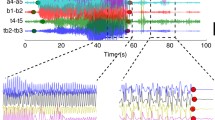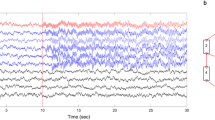Abstract
The directed transfer function (DTF) method is a multichannel analysis based on an autoregressive model that detects flow of seizure activity. This report extends the application of the DTF method to compare patterns of flow of seizures with different sites of origin. Analysis of a seizure originating from mesial temporal structures is compared with a seizure originating from lateral temporal neocortex; both complex partial seizures were recorded with intracranial electrodes that combine subdural grid arrays and depth electrodes. The DTF method has the potential to determine patterns of flow of activity, including periods when visual analysis of the intracranial ictal EEG may not allow for definitive source localization. The extension of the DTF analyses into integrated DTF (IDTF) formats is also illustrated. When activity of a relatively discrete frequency can be identified, the IDTF analysis facilitates display of patterns of flow of this selected activity.
Similar content being viewed by others
References
Barry, E., Wolf, A.L., Huhn, S.L., Bergey, G.K. and Krumholtz, A. Presurgical evaluation of patients with refractory complex partial seizures using simultaneous subdural grid and depth electrodes. J. Epilepsy, 1992, 5: 111–118.
Burgerman, R.S., Sperling, M.R., French, J.A., Saykin, A.J. and O'Conner, M.J. Comparison of mesial versus neocortical onset temporal lobe seizures: neurodiagnostic findings and surgical outcomes. Epilepsia, 1995, 36: 662–670.
Ducrow, R.B. and Spencer, S.S. Regional coherence and the transfer of ictal activity during seizure onset in the medial temporal lobe. Electroenceph. clin. Neurophysiol., 1992, 82: 415–422.
Franaszczuk, P.J., Bergey, G.K., Alemayehu, S., Barry, E. and Eisenberg, H. Multichannel autoregressive analysis of propagation of mesial temporal lobe seizures. Epilepsia, 1995, 36(Suppl 4): 6.
Franaszczuk, P.J., Bergey, G.K. and Kaminski, M. Analysis of mesial temporal seizure onset and propagation using the directed transfer function method. Electroenceph. clin. Neurophysiol., 1994, 91: 413–427.
Franaszczuk, P.J., Bergey, G.K., Durka, P.J. and Eisenberg, H. Time-frequency analysis using the matching pursuit algorithm applied to seizures originating from the mesial temporal lobe. Electroenceph. clin. Neurophysiol., in press.
Franaszczuk, P.J. and Bergey, G.K. Application of multichannel autoregressive techniques to measure synchronization of cortical EEG during preictal, ictal, and postictal periods. Epilepsia, 1997, 38: 116.
Gotman, J. Measurement of small time differences between EEG channels: method and application to epileptic seizure propagation. Electroenceph. clin. Neurophysiol., 1983, 56: 501–514.
Kaminski, M., Blinowska, K. and Szelenberger, W. Topographic analysis of coherence and propagation of EEG activity during sleep and wakefulness. Electroenceph. clin. Neurophysiol., 1997, 102: 216–227.
Kaminski, M. and Blinowska, K.J. A new method of the description of the information flow in the brain structures. Biol. Cybern., 1991, 65: 203–210.
Korzeniewska, A., Kasicki, S., Kaminski, M. and Blinowska, K.J. Information flow between hippocampus and related structures during various types of rat's behavior. J. Neurosci. Meth., 1997, 73: 49–60.
Marple, S.L. Digital Spectral Analysis with Applications. Prentice-Hall, Englewood Cliffs, N.J., 1987.
Matsuoka, L.K. and Spencer, S.S. Seizure localization using subdural grid electrodes. Epilepsia, 1993, 34(Suppl. 6): 8.
Mwaisela, F.J., Alemayehu, S., Bergey, G.K., Krumholz, A., Eisenberg, H., Wolf, A. and Fleming, C.P. Temporal lobe neocortical epilepsy: identification with combined subdural and depth electrode recordings. Epilepsia, 1996, 37(Suppl 5): 147.
Serio, C. Autoregressive representation of time series as a tool to diagnose the presence of chaos. Europhys Lett., 1994, 27(2): 103–108.
Walczak, T.S. Neocortical temporal lobe epilepsy: characterizing the syndrome. Epilepsia, 1995, 36: 633–635.
Williamson, P.D. Frontal lobe seizures: problems of diagnosis and classification. In: P. Chaauvel, A.V. Delgado-Escueta, E. Halgren and J. Bancaud (Eds.), Frontal Lobe Seizures and Epilepsy, Advances in Neurology, Vol. 57. Raven Press, New York, 1992: 289–309.
Author information
Authors and Affiliations
Rights and permissions
About this article
Cite this article
Franaszczuk, P.J., Bergey, G.K. Application of the Directed Transfer Function Method to Mesial and Lateral Onset Temporal Lobe Seizures. Brain Topogr 11, 13–21 (1998). https://doi.org/10.1023/A:1022262318579
Issue Date:
DOI: https://doi.org/10.1023/A:1022262318579




